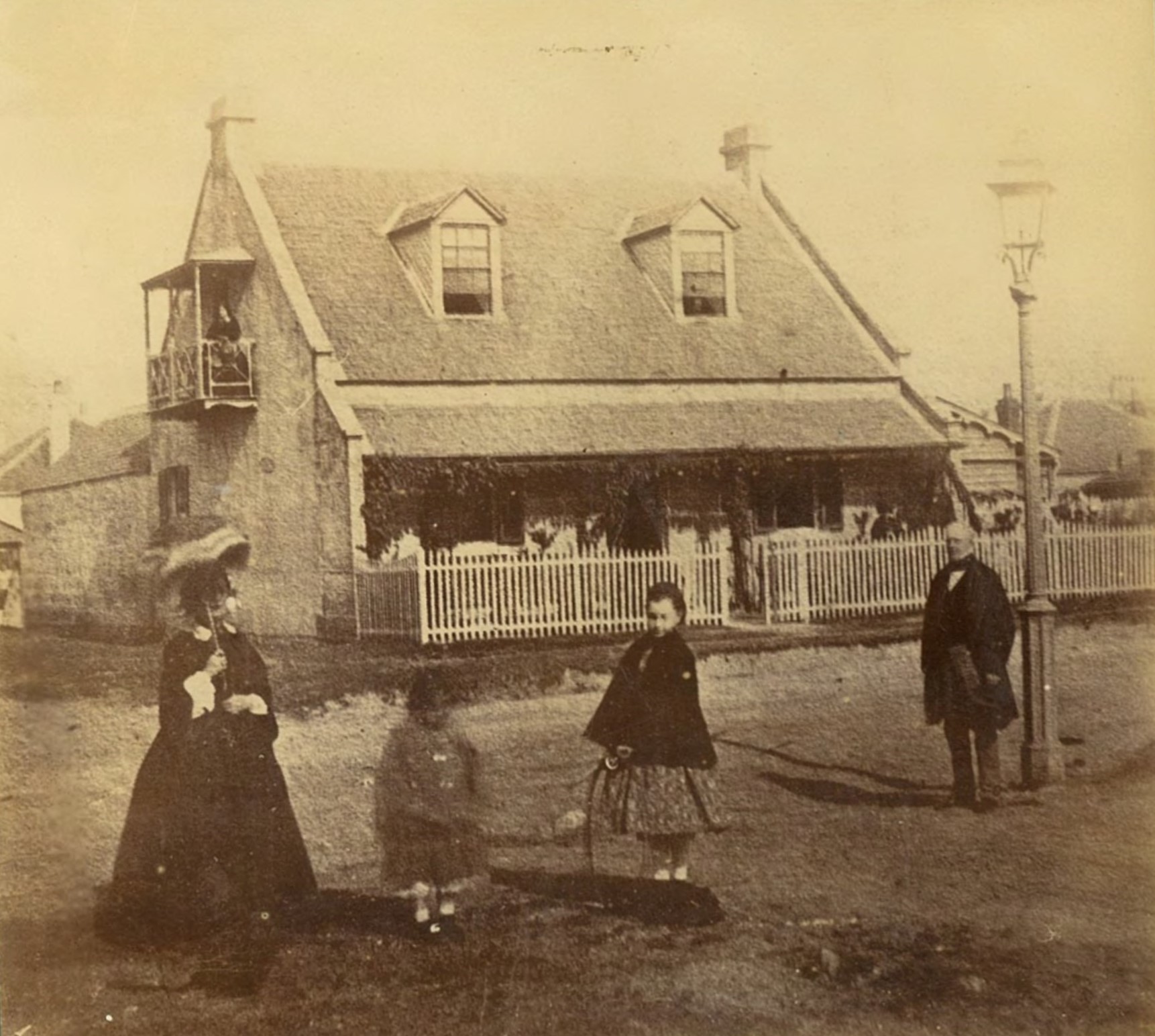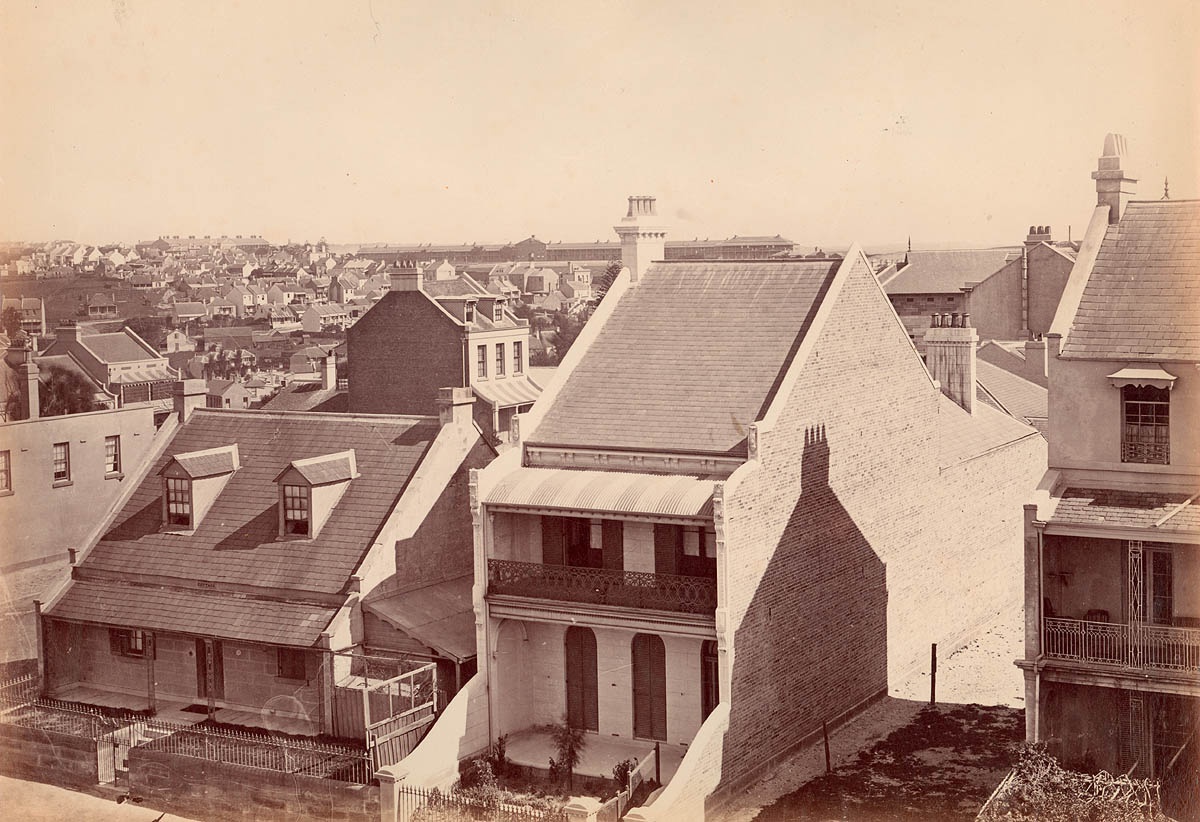Life on Liverpool Street

Husband family outside Oak Cottage, Liverpool Street, Darlinghurst, c1859
Photoprint from Caroline Simpson Library and Research Collection, Museums of History NSW, [34634]
In November 1855 the Husband family moved into a single-storey stone cottage on the corner of Liverpool and Darley streets, which they leased from their esteemed friend, George Wigram Allen. Oak Cottage featured a slated roof above an attic space with dormer windows. It had a front verandah and contained six rooms, a kitchen, stable and coach house.1
Caroline recorded the move in her diary, receiving new furniture for the dining room, making all the beds with her sister, Fanny, and hanging pictures in the drawing room where they entertained their friends, played cards and danced the polka and quadrille.2
Over the next four months, the Husband girls enjoyed drives to South Head, dinner parties, and ‘a box at the Opera’ where they watched the great soprano, Madame Anna Bishop, one of the ‘first truly world-famous European opera stars to perform in Sydney.’3
By the middle May 1856, Caroline was married to the wealthy pastoralist, Henry Arding Thomas, and the couple promptly moved to his Armidale property, ‘Saumarez’. Over the next 22 years, Caroline lost her beloved sister, Cordy, during the 1857 Siege of Lucknow in India, lived through 11 pregnancies and the deaths of five of her children, and settled in Camden, New South Wales. Her husband predeceased her in 1884 and diary entries ended in 1895. She died in 1903.

Oak Cottage (left) on Liverpool Street, Darlinghurst, c1879-82
Undated photograph taken from ‘Hilton’ villa long after the Husband family left, State Library of NSW [SPF/558]
Caroline’s diary contains more than just the fanciful notions of a young woman. They present a lively and, at times challenging and dangerous, portrait of middle class life in mid-19th century Sydney and country New South Wales. Her early entries reveal the goings on of a privileged family, who left the confines of London society and occupied a new social sphere in Darlinghurst, which was perhaps one of comparatively more variety and freedom for a young woman of that time.
From boarding house to ‘Ballina Flats’
On 16 February 1863, James Husband was declared insolvent with liabilities amounting to £1,225, six shillings and twopence and assets at £506 and two shillings, leaving a deficit of £819, four shillings and twopence. At a meeting of his creditors in March, five debts were proven and his official assignee, Robert Hamilton Sempill, was directed to sell Husband’s household and office furniture.4
The Husbands promptly moved out of Oak Cottage and an advertisement for a ‘highly important sale’ of ’elegant and substantial household furniture’ was placed in the Empire newspaper in April 1863.
This included the family’s ‘brilliant toned rosewood cottage piano’, a drawing room suite comprising six chairs, four easy chairs and a lounge, a ‘Canterbury Whatnot’ stand, tables, carpets, vases and ornaments, as well as a book case and 300 books, mahogany dining room chairs and more. The family moved to the north shore in St Leonards, where James died in 1878, aged 74, and his wife, Jane, in 1880, aged 73.5
In the meantime Oak Cottage was advertised for lease after the furniture sale by landlord and friend, George Allen. It was leased to several individuals including a Mr L Paterson in 1864, who apparently kept a pet ‘kangaroo pup’.
Between 1914 and 1921 Oak Cottage was converted to ‘Fairmont Flats’, and although advertised as containing 7 or 8 flats it essentially functioned as a boarding house. It was then demolished in about 1939 to make way for the Art Deco ‘Ballina’ flat building, designed by architect, Dallas Edward Walsh.6
So too disappeared any trace of the cottage and its respectable occupants, who had fled bailiffs in London for a new life; a life spent among Sydney’s elite, in society balls, being seen at plays and the opera and taking long drives along the harbour.
Author’s note
I’d like to acknowledge the work of Australian historian, Anne Philp, and her book, Caroline’s Diary: A woman’s world in colonial Australia (2015), in the production of this story.
Read the next story: Darlinghurst Skating Rink.
Anne Philp, Caroline’s Diary: A woman’s world in colonial Australia (Spit Junction, NSW: Anchor Books Australia, 2015), 95 and Assessment Book - Fitzroy Ward, 1855 (01/01/1855 - 31/12/1855), [A-01089285]. City of Sydney Archives, https://archives.cityofsydney.nsw.gov.au/nodes/view/1842177. The c1859 photograph in front of Oak Cottage shows Mr and Mrs Husband (far left and far right) probably with their youngest daughter, Emily (middle right) and granddaughter, Caroline Georgiana ‘Georgie’ Home Thomas (the daughter of Cordelia née Husband). ↩︎
Philp, Caroline’s Diary, 96-99. ↩︎
Graeme Skinner, ‘Bishop, Anna’, Dictionary of Sydney, 2008, http://dictionaryofsydney.org/entry/bishop_anna and Philp, Caroline’s Diary, 101. ↩︎
‘Insolvency Court—Monday’, Empire, 17 February 1863, 5, http://nla.gov.au/nla.news-article60522945, ‘Insolvency Court’, Sydney Mail, 14 March 1863, 12, http://nla.gov.au/nla.news-article166652092 and ‘In the Insolvent Estate of James Husband’, New South Wales Government Gazette, 14 April 1863, 874, http://nla.gov.au/nla.news-article225242458. ↩︎
‘Advertising’, Empire, 20 April 1863, 7, http://nla.gov.au/nla.news-article63130626, ‘Advertising’, Sydney Morning Herald, 10 February 1866, 12, http://nla.gov.au/nla.news-article13126151, ‘Family Notices’, Sydney Morning Herald, 7 June 1878, 1, http://nla.gov.au/nla.news-article13416324 and ‘Family Notices’, Sydney Daily Telegraph, 16 April 1880, 2, http://nla.gov.au/nla.news-article238482512. ↩︎
‘Advertising’, Sydney Morning Herald, 28 April 1863, 8, http://nla.gov.au/nla.news-article13077718, ‘Advertising’, Sydney Morning Herald, 5 April 1864, 6, http://nla.gov.au/nla.news-article13094527, Assessment Book - Bligh Ward, 1921 (01/01/1921 - 31/12/1921), [A-01089446]. City of Sydney Archives, https://archives.cityofsydney.nsw.gov.au/nodes/view/1842338 and Assessment Book - Fitzroy Ward, 1945 (01/01/1945 - 31/12/1945), [A-01089257]. City of Sydney Archives, https://archives.cityofsydney.nsw.gov.au/nodes/view/1842149. ↩︎

